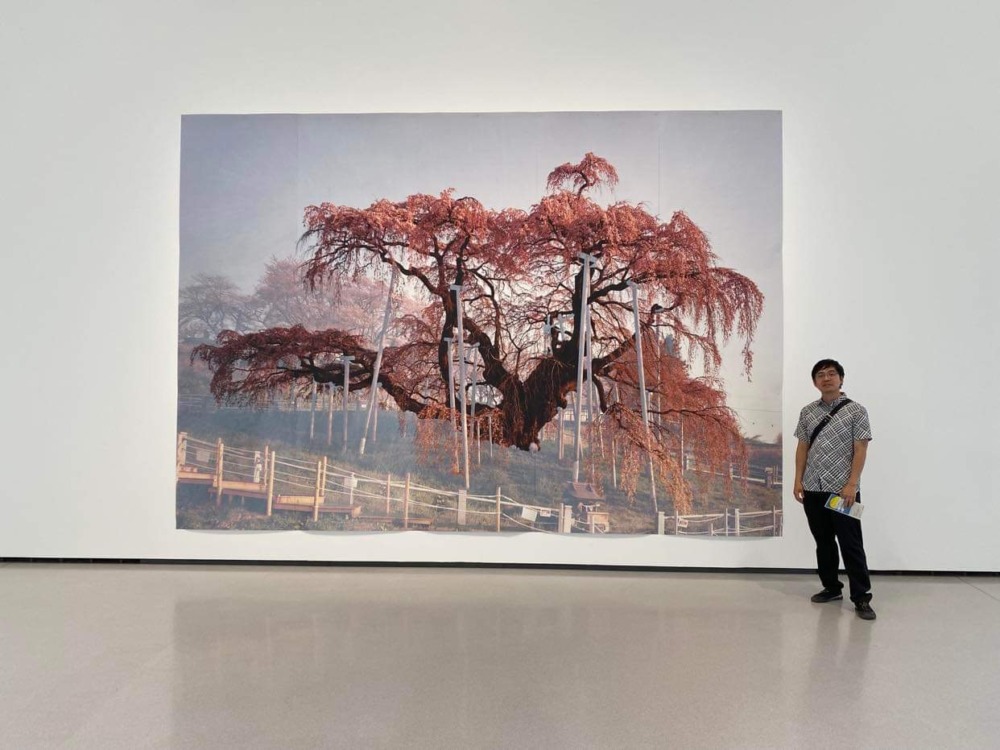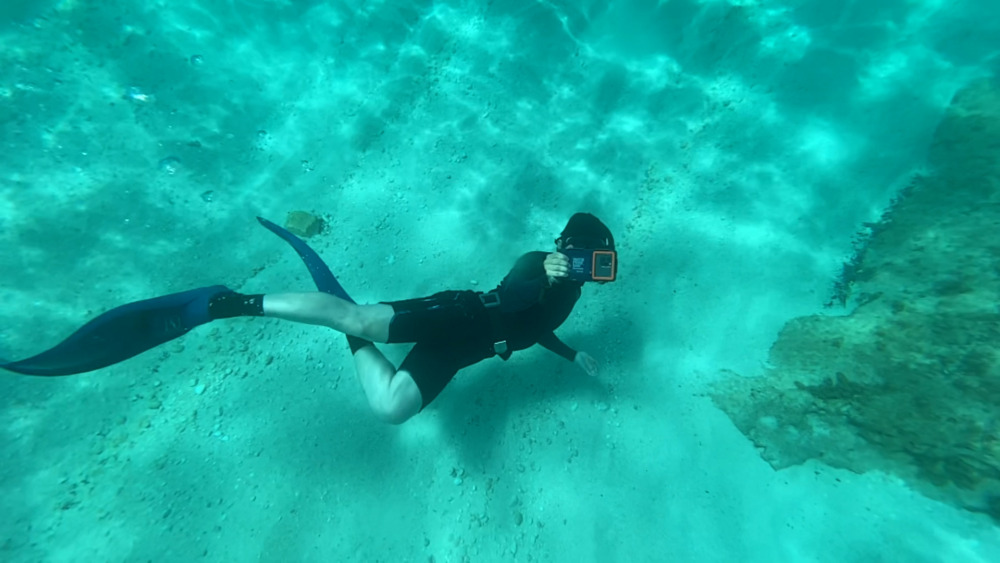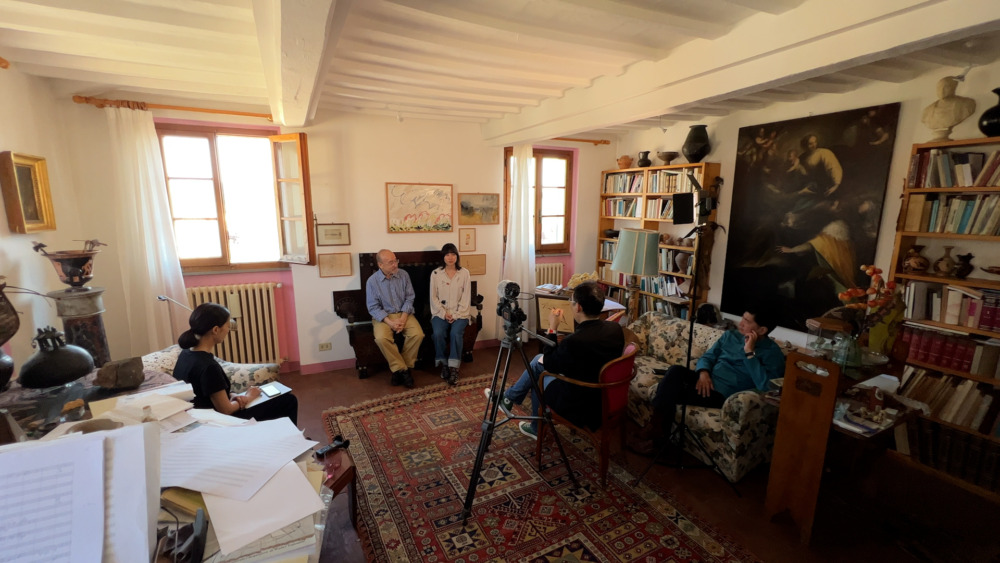Column
ColumnThe Sea of Sardinia: A Pattern of Light [Nao Yoshigai & Hirofumi Nakamoto New Films Production Report]
The team traveled around Italy for the filming of new films co-directed by Nao Yoshigai and Hirofumi Nakamoto. The first half of the trip was spent in Città di Castello, where Sciarrino lives, for a discussion between Nao Yoshigai, director of the opera “Lohengrin” to be performed at Kanagawa Prefectural Hall in 2024, and composer Salvatore Sciarrino. Yoshigai is a film director and dancer, and for the first time, he is directing an opera. As a filmmaker, I accompanied her, not only to document the interviews, but also because Madoka asked me to make a film about the trip itself. The second half of the trip was spent on the island of Sardinia, where we spent six days shooting a film about the sea. Finally, we visited Paris and the Bourse de Commerce – Pinault Collection to see a new work by Tacita Dean, an artist for whom I worked as a production assistant last year.

We first entered Italy through the airport in Florence and stayed overnight in Florence. The three members from Japan were Nao Yoshigai, Madoka Ogino, an employee of Kanagawa Prefectural Hall, and myself. The next day, we met up with Yoichi Sugiyama, a composer living in Italy, and Yuji Numano, a musicologist and artistic advisor of Kanagawa Prefectural Hall, in Florence. We traveled by train to Arezzo and took a cab to Città di Castello. On that trip, we visited the atelier of composer Salvatore Sciarrino for an interview. Mr. Sciarrino’s studio was filled with paintings, both old and new, on the walls, as well as sculptures from around the world and many historical documents, which showed his deep knowledge of various artistic fields. On the first day, both sides were tense, and with Sugiyama’s interpreter in between, they engaged in an in-depth dialogue for more than three hours. The next day, we happened to run into Mr. Sharino while shopping at the market in the early morning. He showed us around Città di Castello, taking us to various places of interest, including a church, a relief carved on a casual wall, and a recommended cafe. After that, we revisited Mr. Sharino’s studio. On the third day, we parted ways with Sugiyama and Numano and visited the huge museum of Alberto Burri, a painter born in this city, and also attended the opening of Museo Malakos, a shell museum in the suburbs. A large number of local residents, young and old, who attended the opening gave us a sense of the cultural soil of the area; on the morning of the fourth and final day, we attended mass at the town’s church. After that, we took a cab to Arezzo, parted ways with Ogino, and headed for Rome from Arezzo with Yoshigai. In Rome, they visited the Roman Forum and St. Peter’s Basilica in the Vatican City.
Then we flew from Rome to Cagliari on the island of Sardinia, where they stayed overnight. We drove to Cala Gonone in a rented car. Cala Gonone is a port town in the Gennargentu National Park facing the Gulf of Orosei. It is located in the eastern part of the island of Sardinia and is home to precipitous mountains and beautiful blue beaches. The town was inhabited in the Nuragic Era more than 730 B.C., but the town to the present day was a fishing colony on the island of Ponza in the early 20th century and was isolated from the rest of Sardinia due to its harsh terrain until the opening of a tunnel in 1860. On the first day, we first did a quick test shoot on a small beach right in front of where we were staying. The small bay was dotted with sandy, stony, and rocky areas, giving us a sense of the topographical richness of the area. On the second day, we drove to Baunei. The beach at Cala Goloritzé, a designated Italian National Monument, is the destination, but to get there, we had to cross a mountain road on foot for about two hours each way. The rock surface is covered with carbonate minerals, and the contrast between the white rock surface and the green shrubs scattered about the area is striking. After passing through the mountain path, we found a bright emerald blue sea that overwhelmed the other beaches. The beach is accessible by boat, although admission is restricted, and although there were more people there than expected, we were still able to experience firsthand the overwhelming allure of this place. Over the next few days, we visited several beaches, including Cala Luna and Cala Fuili, as well as the Grotta del Blue Marino, a limestone cave on the quay, by boat.

One of the highlights of the filming in Sardinia was the underwater dance performance by Nao Yoshigai. As she became accustomed to the sea of Sardinia, Yoshigai’s underwater dance became freer and freer with each passing day. Naturally, since filming was also done underwater, I myself rotated around Yoshigai like a satellite, filming her from above as she sank deep into the water, and looked up at the sun’s rays from deep in the water. Yoshigai would also filming, sometimes leaving each other’s cameras underwater so that we could both swim around the camera. The sea was generally quiet, but the intricate patterns of underwater light created by the gentle rustling of the endlessly blue ocean surface were something that could only be captured at this location.
On the way back from Cala Gonone, we stopped at San Giovanni di Sinis in Ostarino on the west coast of Sardinia. Sardinia has a wide variety of archaeological sites throughout the entire island, but the site of Taros, located here, is of particular archaeological importance. The Sinis peninsula, with its characteristic long and narrow geography surrounding the bay, has beaches on both the east and west sides. On the day we visited, strong winds were blowing from the west, but the east side was very calm, so we were able to snorkel in a relaxed atmosphere. From the sea on the east side, it was possible to film the ruins of a former church building with its two large pillars in the background, creating a sort of end-of-the-world atmosphere. Unlike Cala Gonone, where the sea deepens right off the coast, the shallow waters here have a lot of seaweed growing in them. It seemed to be the season when fish eggs were hatching, and we were able to swim and film them along with a great number of small fish.
The roads along the mountains are narrow and I have to be very careful when driving a rental car, but the Italian cars were all driving at a stormy speed, so I had to keep our eyes on the road. Due to the cheap yen, we mostly cooked our own meals to save money. The local produce, such as large eggplants, tomatoes, lemon and fennel vegetables, shrimp, squid, fish, and thick slices of beef from the market, simply grilled with salt and olive oil, helped my body recover from all the snorkeling, mountain hiking, and filming.

In Paris, we visited the Bourse de Commerce – Pinault Collection for a viewing of Tacita Dean’s new work. The Pinault Collection building was used as a grain exchange in the 18th century and was renovated by architect Tadao Ando. In the center of the circular building is a large atrium, where a huge installation using 35mm film by Tacita Dean was installed. In one of the exhibition rooms was a photographic work of Japanese cherry blossoms, which I assisted on, taken with an 8 x 10 film camera and stretched to 348 cm x 5 m to fit the museum space. Furthermore, the background was painted translucent with white colored pencils to emphasize the giant cherry trees themselves. The Japanese cherry blossoms seen at the end of a long journey brought healing from the depths of my body and soul through their refined appearance.
There were many other memorable moments, but that is all for now. The next step is to edit the vast amount of film material I shot in Italy. The material shot in Città di Castello will be used for the Kanagawa Prefectural Hall project. The material shot in Sardinia will be edited for submission to next year’s film festival. We will consider submissions to European documentary film festivals such as Visions du Réel and the Ji.hlava Film Festival, as well as various Italian film festivals. As a side note, just after we left Paris, there were reports of major riots. We hope that the situation will be brought under control as soon as possible and that the people will recover.
* Participated in the Mobility Support “Passport Program” (For details, refer to this page)








